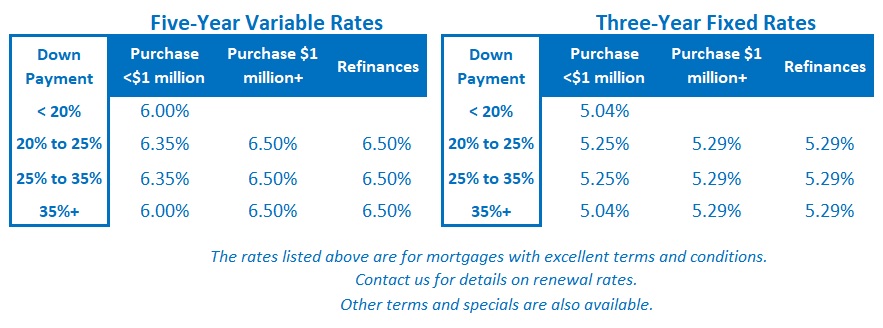Five Important Updates on Canadian Mortgage Rates
March 25, 2024Why the Bank of Canada Probably Won’t Talk About Rate Cuts This Week
April 8, 2024
Mortgage-related news made headlines again last week.
Statistics Canada released our latest GDP data, our banking regulator announced a new set of guidelines for federally regulated lenders, and Prime Minister Trudeau proposed a new Renters Bill of Rights.
Here are my takes.
Our Latest GDP Data
Stats Can estimated that our GDP increased by 0.6% in January on a month-over-month basis, well above the consensus forecast of 0.4%.
Most of last month’s growth came from the public sector and was primarily attributed to the end of education worker strikes in Quebec. That said, Stats Can reported growth in 18 of the 20 categories it tracks, and our GDP still increased by 0.3% month-over-month with the educational-sector rebound excluded.
That result was well above the BoC’s expectations, but there are also a few important caveats to factor in.
For starters, unseasonably warm weather in January provided a boost, but that was as an anomaly, not a trend.
It is also important to note that our surging immigration rates have once again caused our economic output to increase on an overall basis, even as it declines on a per-capita basis. The latter trend is a better (and more concerning) indicator of the real momentum in our economy because it applies to individual Canadians.
In addition, Stats Can massages our raw GDP data in an attempt to smooth out short-term noise, and that practice can, by the BoC’s own admission, obscure important signals when our economy is shifting between expansion and contraction.
Case in point: Stats Can’s initial estimate for month-over-month GDP growth in December was positive (+0.3%) but was subsequently revised down twice, and the final estimate for that month came in at -0.1%. (Hat tip to Bruno Valko for that detail.)
Those adjustment factors help to explain why bond market investors seemed to shrug off the latest GDP data and continue to expect the BoC’s first rate cut in June at the earliest and July at the latest.
Our Banking Regulator Tightens up Lending Rules but Still Won’t Provide Relief to Trapped Borrowers
Last week our banking regulator, the Office of the Superintendent of Financial Institutions (OSFI), announced that as of Q1 2025, it will cap the number of uninsured mortgages that each lender can issue where the loan amount is greater than 4.5 times the associated income.
The cap will vary by individual lender, based on their portfolio makeup and risk profile.
OSFI has been floating the idea of a loan-to-income (LTI) cap for some time, but it still came as a surprise given our current backdrop. Thus far in 2024, only 12% of new mortgages have exceeded an LTI ratio of 4.5, as compared to 26% in 2022. (Hat tip to economist Ben Rabidoux for that stat.)
That’s why the announcement was a surprise. Introducing an LTI cap now is akin to throwing water on a fire that is already out.
I think OSFI is making this tweak for three reasons:
- To give it the ability to individually limit lenders who are taking on too many high LTI borrowers. (They’re looking at you, CIBC).
- To ensure that it has tighter controls in place when mortgage rates fall and borrowing capacities increase.
- To make it harder for owners of multiple properties to increase their leverage (at least via the federally regulated prime mortgage market, which OSFI oversees).
Another recent announcement by OSFI got much less attention.
Our Canadian Competition Committee, a government watchdog that “protects and promotes competition for the benefit of Canadian consumers and businesses” urged OSFI to stop requiring uninsured borrowers (who represent about 75% of total mortgage borrowers) to pass the mortgage stress-test if they want to move to a different lender at renewal provided they are not making any changes to their loan.
As I noted when the stress-test was first introduced and have reiterated many times since then, this anti-competitive requirement traps the most vulnerable borrowers at their existing lenders and often forces them to renew at uncompetitive rates.
The Competition Committee’s recommendation provided brief hope that OSFI would take a fresh look at the requirement, especially since higher mortgage rates have increased the number of borrowers who are being impacted by this punitive policy.
Disappointingly, OSFI responded by restating its existing position, which is essentially as follows:
A loan that was stress-tested (typically) five years ago and isn’t re-evaluated in any way at renewal is deemed to be less risky than a loan that is moved to a different lender and fully re-underwritten based on the borrower’s current circumstances, unless a stress-test is also applied. This is true even when those borrowers are forced to renew with their existing lender at higher rates, which will put them under additional financial strain.
From a purely risk perspective, let alone a competitive one, OSFI’s position makes no sense.
Our Prime Minister’s Empty Pitch to Renters
During his speech last week, Prime Minister Trudeau announced that a new “Bill of Rights” for renters would be included in the upcoming federal budget.
The media parsing through his proposal should have been experiencing déjà vu.
In its 2022 budget, our federal government put forward a Home Buyer’s Bill of Rights, and this blogger was among those who diligently reviewed the details. But none of the proposals were subsequently enacted, and the Home Buyer’s Bill of Rights was never heard from again.
Anyone remember the proposal that lenders be required to inform every borrower about the First-Time Home Buyer Incentive (FTHBI)? That was a federal program that wasn’t getting any traction back then, ostensibly because mortgage professionals weren’t making borrowers aware of it. It’s the same program that the Feds finally kyboshed earlier this year for lack of take up.
I’m going to hold off on reviewing Prime Minister Trudeau’s latest proposal until it shows up on the House floor. Fool me once …  The Bottom Line: Government of Canada bond yields remained range bound last week, and the same was true for both our fixed and variable mortgage rates.
The Bottom Line: Government of Canada bond yields remained range bound last week, and the same was true for both our fixed and variable mortgage rates.
We’ll learn the results from the latest Business Outlook and Consumer Expectations Surveys today, and we’ll have the latest employment data on Friday. These will be the last key releases before the BoC’s next policy-rate meeting on April 10.
I’ll be back next week with my take on those important data along with my prediction on what we’ll hear from the BoC at its next meeting.







